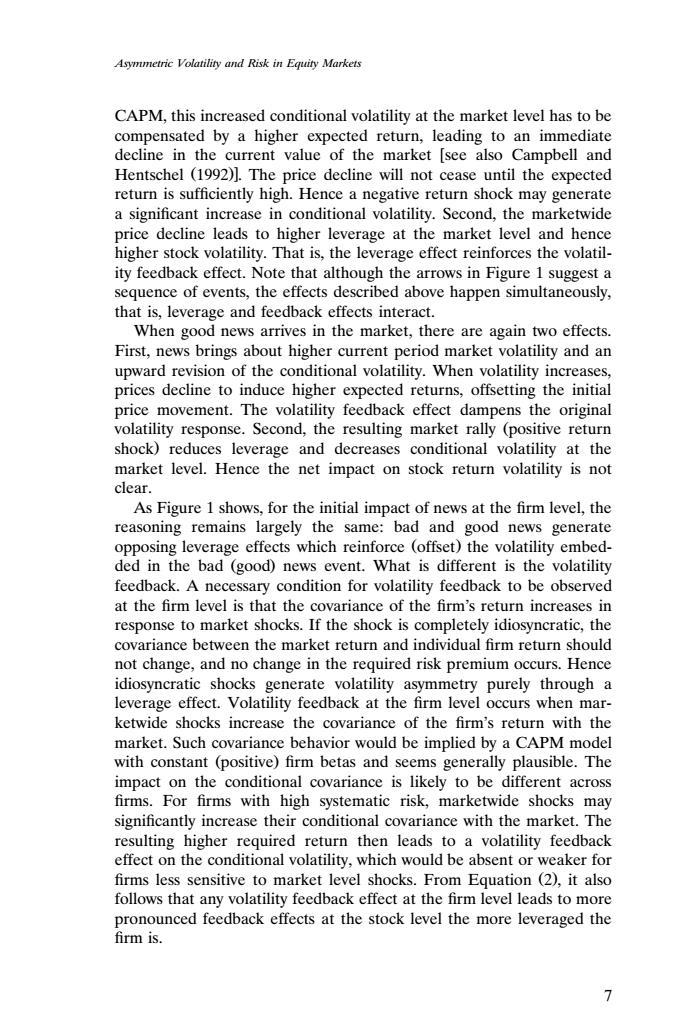正在加载图片...

Asymmetric Volatility and Risk in Equity Markets CAPM,this increased conditional volatility at the market level has to be compensated by a higher expected return,leading to an immediate decline in the current value of the market [see also Campbell and Hentschel (1992)].The price decline will not cease until the expected return is sufficiently high.Hence a negative return shock may generate a significant increase in conditional volatility.Second,the marketwide price decline leads to higher leverage at the market level and hence higher stock volatility.That is,the leverage effect reinforces the volatil- ity feedback effect.Note that although the arrows in Figure 1 suggest a sequence of events,the effects described above happen simultaneously, that is,leverage and feedback effects interact. When good news arrives in the market,there are again two effects. First,news brings about higher current period market volatility and an upward revision of the conditional volatility.When volatility increases, prices decline to induce higher expected returns,offsetting the initial price movement.The volatility feedback effect dampens the original volatility response.Second,the resulting market rally (positive return shock)reduces leverage and decreases conditional volatility at the market level.Hence the net impact on stock return volatility is not clear. As Figure 1 shows,for the initial impact of news at the firm level,the reasoning remains largely the same:bad and good news generate opposing leverage effects which reinforce (offset)the volatility embed- ded in the bad (good)news event.What is different is the volatility feedback.A necessary condition for volatility feedback to be observed at the firm level is that the covariance of the firm's return increases in response to market shocks.If the shock is completely idiosyncratic,the covariance between the market return and individual firm return should not change,and no change in the required risk premium occurs.Hence idiosyncratic shocks generate volatility asymmetry purely through a leverage effect.Volatility feedback at the firm level occurs when mar- ketwide shocks increase the covariance of the firm's return with the market.Such covariance behavior would be implied by a CAPM model with constant (positive)firm betas and seems generally plausible.The impact on the conditional covariance is likely to be different across firms.For firms with high systematic risk,marketwide shocks may significantly increase their conditional covariance with the market.The resulting higher required return then leads to a volatility feedback effect on the conditional volatility,which would be absent or weaker for firms less sensitive to market level shocks.From Equation(2),it also follows that any volatility feedback effect at the firm level leads to more pronounced feedback effects at the stock level the more leveraged the firm is. 7Asymmetric Volatility and Risk in Equity Markets CAPM, this increased conditional volatility at the market level has to be compensated by a higher expected return, leading to an immediate decline in the current value of the market see also Campbell and Hentschel 1992 . The price decline will not cease until the expected Ž . return is sufficiently high. Hence a negative return shock may generate a significant increase in conditional volatility. Second, the marketwide price decline leads to higher leverage at the market level and hence higher stock volatility. That is, the leverage effect reinforces the volatility feedback effect. Note that although the arrows in Figure 1 suggest a sequence of events, the effects described above happen simultaneously, that is, leverage and feedback effects interact. When good news arrives in the market, there are again two effects. First, news brings about higher current period market volatility and an upward revision of the conditional volatility. When volatility increases, prices decline to induce higher expected returns, offsetting the initial price movement. The volatility feedback effect dampens the original volatility response. Second, the resulting market rally positive return Ž shock reduces leverage and decreases conditional volatility at the . market level. Hence the net impact on stock return volatility is not clear. As Figure 1 shows, for the initial impact of news at the firm level, the reasoning remains largely the same: bad and good news generate opposing leverage effects which reinforce offset the volatility embed- Ž . ded in the bad good news event. What is different is the volatility Ž . feedback. A necessary condition for volatility feedback to be observed at the firm level is that the covariance of the firm’s return increases in response to market shocks. If the shock is completely idiosyncratic, the covariance between the market return and individual firm return should not change, and no change in the required risk premium occurs. Hence idiosyncratic shocks generate volatility asymmetry purely through a leverage effect. Volatility feedback at the firm level occurs when marketwide shocks increase the covariance of the firm’s return with the market. Such covariance behavior would be implied by a CAPM model with constant positive firm betas and seems generally plausible. The Ž . impact on the conditional covariance is likely to be different across firms. For firms with high systematic risk, marketwide shocks may significantly increase their conditional covariance with the market. The resulting higher required return then leads to a volatility feedback effect on the conditional volatility, which would be absent or weaker for firms less sensitive to market level shocks. From Equation 2 , it also Ž . follows that any volatility feedback effect at the firm level leads to more pronounced feedback effects at the stock level the more leveraged the firm is. 7�